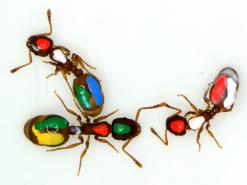Tracking ants as computer gaming

-
People spend millions of hours playing Farmville on Facebook, or
Sudoku in the airplane. Therefore there is an opportunity to harness
such Human Power Units (HPU) cycles for more productive, but still
enjoyable, work. Recently, it was shown that untrained "citizen
scientists" can be effectively used to help solve problems in various
scientific settings: form Gallaxy Zoo which helps astronomers with
image labeling, to FoldIt which helps biologists with protein folding.
We study the problem of extracting one accurate trajectory from
several (possibly inaccurate) trajectories, where the input
trajectories come from individual traces created by people tracking
moving ants or bees over time. We would like to create an appealing
and entertaining platform (desktop or phone) which would allow us to
divert a few HPUs from Farmville and Angry Birds towards consenus
trajectory generation. Creating an appealing online game experience
from tracking ants or from image segmentation poses interesting
design, presentation, and aesthetics challenges.
Ecology & Evolutionary Biology professor Anna Dornhaus has provided us with videos of color coded ants moving around and working in their colonies. We would like to develop an online game that (1) displays short segments of the ant video, (2) specifies an ant to be traced and (3) allow the users to trace the ant's path via mouse clicks. The game should allow users to pause the video, undo moves, and submit a traced path once they are satisfied with it. We also want to create an appealing and entertaining for experience for users. Some ways to do this is by allocating points, displaying the highest scoring users to all users, allowing users to advance to higher levels where they are asked to trace longer and more challenging paths.
Once game players submit paths, the application will also need to validate the paths that are submitted. This is especially necessary as the data will be submitted by untrained volunteers. A standard approach for data validation is to ask several people to trace the same ant and use several different traces to extract the ``true" trajectory of the ant. While extracting an accurate measure from several numerical estimates is easily done by computing the average, computing the average of trajectories is not straightforward. Existing approaches that compute average of trajectories use clustering, alignment or sampling. However it is not clear which of these methods will lead to good solutions for our setting. Thus the second part of the project will be to implement and test several algorithms to identify the most robust method for extracting one accurate trajectory from several (possibly inaccurate) trajectories.
Funding or course credit is available.
Contact Details - Aparna Das, aparna@cs.arizona.edu
Mine safety training with 3D games and Augmented Virtual Reality
-
With the expansion and diversification of the mining industry
workforce, trainers have identified a growing need for new and more
versatile training materials. We are developing a suite of 3D video
games
to serve as interactive learning scenarios for mine safety training.
Our initiatives focus on mine emergency preparedness and the
reconstruction of mine fatality accidents. We seek one or more students
to get involved in the design and programming aspects of this work.
Specifically, the student(s) will develop a simple game for teaching
mine terminology to second language learners, in support of our
emergency preparedness training. The student(s) will be using an
industry standard game engine, the
Unreal Development Kit, to create this new learning scenario, and
will be working with an inter-disciplinary team consisting of
professional artists, academics, and industry representatives.
As an example of our on-going work, we have put together a short demo video showing a mine fatality accident ("fatalgram") that was reconstructed into an interactive 3D game. (Note: the video is large; right click and download it to your drive to view.) The game allows a user to both watch the events of the accident unfold as a 3D movie, and to dive into the simulation to change its outcome. Scenarios are being developed to emphasize safety practices for a variety of common accidents.
Additionally, we are exploring non-traditional and emerging human computer interfaces (HCI) as vehicles of the training process. For example, imagine a 3D training game in a multi-user "virtual reality" room where trainees interact with physical props that have meaning in their workplace. Further, imagine that the room is vision-enabled, so that it can sense hand gestures, allowing the trainees to interact with the entire workspace through a uniform set of gestures and meaningful deictic references. Dr. Hong Hua's 3DVIS lab has built an augmented virtual environment, called hybrid-SCAPE, that incorporates many of these exciting capabilities. We are interested in exploring these technologies in new applications (e.g. such as in safety training) and evaluating their utility in practice.
Funding is available.
Details -
Overview of the mine safety & health training initiative
Overview of the 3DVIS lab and hybrid-SCAPE
If you are interested in participating in any of these research initiatives, please contact Leonard D. Brown (ldbrown at cs).
Imaging for Speech Recognition, and Perception of Agents
-
Details - here
Browsing and Mining videos of Lectures
the SLIC project.-
Details - Kobus Barnard